What's New
Displaying results 4121 - 4130 of 4924
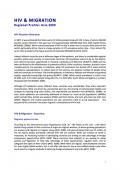
Resource | Publications,
In 2007, it was estimated that there were 4.9 million people living with HIV in Asia, of whom 440,000 became newly infected in the past year and approximately 300,000 died from AIDS‐related illness (#UNAIDS, 2008a). While overall prevalence of HIV in Asia is lower than in certain other parts of the world, particularly Africa, there is a large variation in HIV prevalence within Asia – from almost 0%, up to 2.4% recorded in the Papua province of Indonesia (#UNAIDS & WHO, 2007).
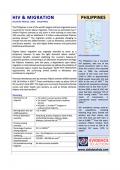
Resource | Publications,
The Philippines is one of the world’s largest and best organised source countries for human labour migration. There are an estimated over 7 million Filipinos overseas at any point in time working in more than 160 countries, with an additional 1.3 million undocumented Filipinos working abroad. The migration profile is gradually changing to include not only less skilled workers ‐ such as domestics, construction and factory workers ‐ but also highly skilled workers and particularly healthcare professionals.
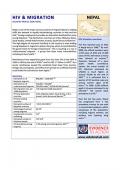
Resource | Fact Sheets,
Nepal is one of the major source countries of migrant laborers, helping fulfill the demand in rapidly industrializing countries in Asia and the Gulf. Foreign employment provides an alternative livelihood for many young Nepalese. Top destination countries are India, Malaysia, Qatar, Saudi Arabia, United Arab Emirates, Kuwait, South Korea and Bahrain. The high degree of economic hardship in the country is even leading young Nepalese to migrate to places, like Iraq, which are prohibited by the government for foreign employment. This is resulting in a rise in undocumented migrants ‐ a group that faces many vulnerabilities, including to their health.
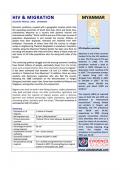
Resource | Fact Sheets,
Domestic conditions, coupled with a geographic location which links the expanding economies of South East Asia, China and South Asia, characterizes Myanmar as a country with dynamic internal and international mobility. Ethnic conflicts are one of the major sources of population displacement in and outside the country. Millions of people have been displaced, relocated and resettled from their birthplace. Thousands of others have fled the country to refugee camps in neighbouring Thailand, Bangladesh or elsewhere. Population mobility along the Myanmar‐Thailand border has been very fluid. So too along the borders with India and China. Many of these areas are also home to hill tribe populations who live along both sides of the border.
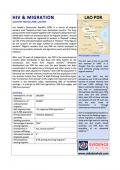
Resource | Fact Sheets,
Lao People’s Democratic Republic (PDR) is a source of migrant workers, with Thailand as their main destination country. The long, porous border with Thailand together with Thailand’s demand for low‐skilled labor make it an attractive option for migrant workers. Around 180,000 Lao nationals are registered as workers in Thailand,2 making up 12% of the estimated migrant workforce in Thailand. These figures do not account for the large number of undocumented migrant workers. Migrant workers from Lao PDR are mainly employed in infrastructure projects, domestic and agriculture work, and the fishing industry.
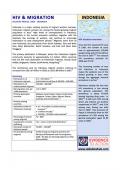
Resource | Fact Sheets,
Indonesia is a major sending country of migrant workers overseas. Indonesian migrant workers are among the fastest‐growing migrant population in Asia. High levels of unemployment in Indonesia, particularly in the current economic condition, together with the relatively low earnings of workers, will continue to encourage Indonesians to seek employment abroad. Migrants come from all over Indonesia, but particularly from South Sulawesi, East and West Java, West Kalimantan, North Sumatra, and East and West Nusa Tenggara.

Resource | Fact Sheets,
Between 1950 and 1980, all internal and international migration was forbidden by the Chinese government. Market reform in the 1980s loosened this government control on internal migration and, in recent years, labor migration to other countries has become part of China’s overall economic strategy.
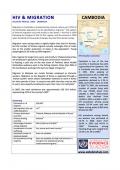
Resource | Fact Sheets,
Cambodia is one of the few countries in Southeast Asia with a generalised HIV epidemic. HIV in Cambodia was first detected in 1991. After peaking at approximately 3.3% in 1998, HIV prevalence among the adult population declined to 1.2% in 2003, and further down to 0.9% in 2005. In 2007, the estimated number of people living with HIV was 75,000, down from 120,000 in 2001. AIDS‐related deaths also declined from 14,000 in 2001 to 6,900 in 2007. HIV prevalence among young people (15‐24 years old) was higher among males (0.8%) than females (0.3%).
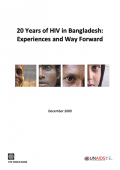
Resource | Publications,
This report synthesizes data from surveillance, behavioral surveys and published and unpublished research to better understand emerging patterns and trends in the HIV epidemic in Bangladesh. Taking stock of 20 years of experience with HIV in Bangladesh, this report summarizes what is known about the coverage and impact of HIV prevention services, including knowledge on risk and protective behaviors.

Resource | Presentations,
Presentation on reducing HIV vulnerability among Injecting Drug Users (IDUs) and their sex Partners.
Harm reduction:
- Methadone Maintenance Therapy to achieve 25,000 coverage by 2010
- Needle Syringe Exchange Program to achieve 15,000 Coverage by 2010
- Safe Sex (Condom use) for the HIV+ve and those who have sex with HIV+ve or unknown HIV status partners





